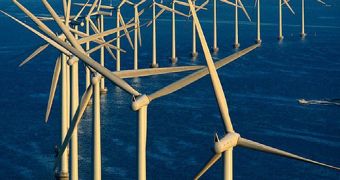Windmills have been used even since the 6th century in Persia (Iran). Unlike the later type used in Europe, this one had a vertical ax with sails which worked on horizontal supports. Mill stones from the inferior end ground the cereals for getting flour. The first mention of a windmill in Europe is that of Bury St Edmunds from Suffolk, England.
The first European windmills were the type pillar mill. The sails rotated on an almost vertical plan, and the body of the mill was mounted on a central pillar. A long pulley, called turn handle, prolonged backwards. When the wind direction changed, the miller pushed the turn handle to rotate the mill to face again the wind.
In time, skilled millers found ways of using the mills for other purposes, too, like draining water out of the fields. A system consisting in a windmill acted a mechanism with a water wheel, which pulled out the water. The main disadvantage of the windmills is that they cannot be used as a continuous source of energy; they stop delivering energy when the wind ceases. Still, even today windmills for grinding cereals are used in some countries.
Wind pumps with multiple blades are used for putting out water from wells in isolated regions like Australia or South Africa, the rotation of the blades being turned into a up and down movement acting the pump. Pumped water is deposited in a nearby tower. This type of wind machines has a wheel with a diameter of 3-4 m (10-13 ft), with about 20 pressed steel palettes. The wheel is mounted on a metallic pillar having the height of about 8 (26) ft. The wind power on a back vertical fin maintains the wheel facing the wind. The fin has the role to avoid damage to the mechanism when the wind turns too strong.
Electricity from wind (eolian energy) is preferred by many because it's clean, devoid of fuel, thus it does not contaminate soil, air and water. In some areas of Wales, Scotland and North America there are wind turbines connected to power generators. A rotor of 50 m (166 ft) in diameter generates 1 MW (one million watts), thus 1,000 of such wind generators would match the capacity of a habitual power plant. In some countries, there are already "wind farms" made of fields of wind generators, but the public opposes them as they perturb the landscapes. It seems that eolian energy on large scale is not so plausible. Still, small wind generators would be a cheap method of recharging batteries in isolated areas, lacking connected to an electricity network. Wind turbines like Darrieus do not even require adjusting to the wind change.
Water wheels are known from the first century BC, being used for grinding cereals. The water flow acted the wheel and the movement was used for grinding cereals between 2 stones. One millenium later, people started to exploit water energy for other processes too, leading to the booming of industries along the valleys.
The right mechanism connected to the water wheel could transmit its energy for acting bellows, saws, and heavy hammers. First industries of paper, iron and textiles based on water energy, till the introduction of the first viable vapor machines to the end of the 18th century. Today, water wheels are rather museum exhibits, but water turbines move immense energy generators in hydroelectric centrals. Norway, for example, gets most of its energy from hydroelectric centrals.
Tides too can be a source of energy, acting turbines connected to power generators. But places where these projects are effective are few, because the generated energy is relatively small. On Rance River (France), the tide generated in its estuary delivers an energy of 100 MW, 10 % of that delivered by an average power plant.
Waves too carry energy, but this is hard to exploit effectively and cheaply. Some systems use rafts that ascend and descend with the passing of the waves. The movement acts a pump, which pushes water into a turbine acting a power generator. Almost the entire energy of the waves can be absorbed by the rafts, as the other side of the sea surface can remain quite.
A technology experimented on the Islay Island (western Scotland) generates 180 KW (180,000 watts), functioning on the principle of the oscillating water column. A submerged room, opened on the inferior part, contains a water column with air above. With the passing of the waves, the water column ascends and descends, pushing and putting out the air through a turbine connected to a power generator.

 14 DAY TRIAL //
14 DAY TRIAL //